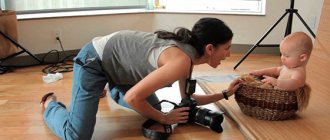10/04/2016 Nadezhda Plotnikova 0 comments
If you give a four-year-old child a pencil, he will probably take it in his fist. Although in this age period this way of grasping writing utensils is considered a relative norm, it is worth thinking about how to teach a child to hold a pen correctly.
An incorrect habit will certainly affect writing and handwriting and even academic performance, since incorrect grip leads to rapid fatigue, inconvenience and reluctance to work in a notebook.
And yet, it is possible to teach a child to write correctly, since there are several effective methods, one of which will definitely appeal to the future student.
Why do children hold pens and pencils incorrectly?
The child’s grasping reflex develops already in infancy, and by the age of one year the baby can confidently hold various objects with his hand. Most often, it is clenched in a fist. This is convenient for him, he sees that with such a “grab” the toy, spoon or pencil does not fall. Even if a child is observant and notices that adults hold a pencil differently, it is not easy for him to repeat this due to insufficiently developed fine motor skills of his fingers.
That is why parents need to not only show how to hold a pen correctly when writing, but also develop fine motor skills in the child’s hands. Finger gymnastics, plasticine modeling or mosaic exercises are great for this. It is useful to teach a child to fasten buttons and string beads on a thread.
It is important to show him that all these actions are convenient to perform with three fingers (practice and consolidate the so-called pinch grip).
Hand motor skills are an important part of learning to write.
If your child cannot learn to work with a pen (pencil), use motor skills exercises. They will also contribute to the development of beautiful handwriting.
There are several accessible ways to train hand motor skills at home, using improvised objects:
- Scatter the beads in a bowl and ask your child to put them back together by stringing them on a string.
- Cut out all kinds of shapes with your baby.
- Invite your child to untie the knots you made in advance.
- Ask your little helper to sew a button to a garment or simply to a piece of fabric.
- Shape the dough together and you'll get the double benefit of a kitchen helper and a child who knows how to work with a pen or pencil.
- You can purchase special horizontal bars for your fingers or contact a physiotherapist (he will suggest a set of exercises).
- Act out a fairy tale with your child. Let his fingers become imaginary characters in the game.
Why is it important to hold the pen correctly?
Incorrect finger position when writing is not only a matter of beautiful handwriting. Everything is much more serious.
Is your child holding a pen incorrectly? Most likely, he is sitting incorrectly. And this can lead to muscle pain, poor posture and, in the long term, scoliosis.
A “crooked” landing is fraught with vision problems.
A hand placed incorrectly quickly gets tired; Even muscle and hand spasms are possible.
And, of course, there is a psychological aspect: it is harder for a child - especially a first-grader - than for his peers. He does not have time, does not receive satisfaction from studying, and begins to be afraid of written work. Ultimately, the child develops a negative attitude towards the entire educational process.
Possible reasons
At school, children have to write a lot and often.
The way the student holds the pen determines his writing speed and handwriting. Many parents are faced with the problem of incorrect positioning of writing instruments in their child’s hand. Most often it is caused by undeveloped fine motor skills. Small children hold pencils, pens, and rattles with all their fingers, clenching them into a fist. Some older kids squeeze the writing instrument by sticking their fingers forward.
This situation is wrong, it often turns into a habit that is quite difficult to get rid of. Therefore, it is important to start retraining the baby in time. Incorrect pen position may be due to the fact that parents did not show how to hold the writing instrument in their hand.
Signs that your child is holding a pen incorrectly
Incorrect finger positioning does not always mean “hand in fist.” There are many options in which a child holds a pen or pencil incorrectly when writing and which are not so obvious:
- The child holds the pen too close or too far from the shaft. A distance of about 1.5 cm is considered optimal.
- Incorrect grip: “pinch” or thumb below index finger.
- Focus on the index finger, not the middle finger.
- Excessive pressure on the writing instrument.
- When writing, the paper moves, but not the pencil.
- The hand is too tight and tense.
- The upper part of the pencil “looks” to the side (should be directed towards the shoulder).
Video on the topic
How to teach a child to hold a pen correctly:
Thus, the problem of improper grip of the handle is relevant for many children 5-6 years old. It is important to solve it before entering school, otherwise the child will have problems with adaptation and academic performance. There are different ways to teach a preschooler to hold a pen.
You can use napkins, nozzles, special accessories, rubber bands, etc. Also, do not forget to monitor the position of the child’s body at the table while writing. It is useful to improve finger dexterity by drawing, modeling, stringing beads, and finger games.
How to hold a pen correctly
With a correct grip, the handle “lies” on the middle finger on the left side in the area of the upper joint. It is supported by the thumb and forefinger: the index finger is on top, the thumb is on the left. You can check the correct position by asking the child to raise his index finger: the handle should not fall or fall to the side.
At the same time, you don’t need to squeeze the handle too much.
The position of the ring and little fingers is not clearly defined - usually the fingers are curved inside the palm. The little finger serves as a support for the entire hand.
It is worth paying attention to the index finger: it should not be overly tense (visually this is noticeable by the strong deflection of the finger).
The same recommendations apply to holding a pencil correctly.
Correct grip
As soon as your child turns three years old, it is time to introduce him to the correct way to hold a pencil. He must understand that there are certain rules that must be strictly followed:
- the middle finger always serves as support;
- the index finger holds the object from above;
- and the big one presses on the left side (fixes the handle);
- The grip height is approximately 2 cm - this is how much the index finger separates from the sheet of paper.
The child must correct all mistakes without fail! To do this, parents gently remind him of the rules and make sure that the baby does not get overtired.
When your hands get tired, an instinctive clenching occurs - your fingers get even more tired! This should be avoided. Sometimes children suddenly change the position of their hand and clench the pencil in their fist. This is one of the symptoms of fatigue.
At what age should a child be taught to hold a pen correctly?
You should not think that teaching a child to hold a pen or pencil correctly is only necessary when preparing for school - that is, after 5 years. Children become familiar with writing objects much earlier. Kids love to draw: on paper, asphalt, books and walls; in the yard, at a party and at home; pencils, chalk and even mom's lipstick.
Whenever the child picks up a pencil, you can try to position the hand correctly.
The most convenient way to start learning is with felt-tip pens or wax crayons - they are bright, soft, and you don’t have to press hard on them. Working with a pencil requires more effort, but this also has benefits: you can learn to control the force of pressing on the paper.
Experts advise that at first you should give your baby very small (up to 3 cm) crayons - it is simply impossible to hold them in your fist and you will have to learn to work with your fingers.
conclusions
It often happens that the child does not want to hold the pen correctly, squeezing it into a fist or holding it in other ways that are convenient for him. Such a bad habit can make any mother nervous, because this makes the baby quickly get tired of writing (or drawing, shading, painting), and not only the child’s handwriting deteriorates, but also his posture. This is why it is very important to teach your child how to hold writing objects correctly. Using the little tricks described in the article, you can make this process more effective and painless.
Techniques to teach a child to hold a pen correctly
It’s good if learning takes place in a playful way and the child does what is interesting to him, and not just “necessary”.
Examples of game exercises:
- "Pencil bed." Explain to your child that the pencil likes to write while lying on a “pillow” (on the upper phalanx of the middle finger) and covered with a “blanket” (from the thumb and index finger).
- Play tracker. Place a bright dot on the child’s finger in the place where the pencil should touch, and a dot of the same color on the pencil itself. Let the child make sure that the “traces” match all the time.
- Use the “extra” fingers. Tell your baby that the little finger and ring finger also want to do something while others are drawing, so you need to find something for them to do: let them hold something soft. They usually suggest placing a folded napkin, cotton ball or eraser under your fingers.
- Hit the gym with your fingers. You can arrange a special exercise machine for your child using a regular rubber band. It is put on the baby's wrist, and the opposite side is twisted and thrown over the upper end of the pencil. This is how the correct inclination is formed when writing. In addition, the elastic band will stretch and press slightly if the child takes the pencil in his fist.
- Another type of simulator is a stationery clip. Place the pencil in the clip and lift the “ears” so that you can place your index finger there. The child must ensure that the finger does not leave the space between the ears.
- “Have mercy” on the pencil. The writing instrument should be placed vertically with the writing part down and the child should be allowed to “stroke” it from top to bottom with three fingers (thumb, index and middle). This way you can help your child feel the correct position of his fingers.
- “Play darts” with a pencil. Perhaps your child will find it more interesting if he imagines that a pen or pencil is a dart that needs to be “thrown” at a piece of paper. You can even draw a target on the sheet.
Exercise to form a correct grip
It is very difficult for a baby to master the correct position of his fingers. Put aside drawing lessons for a while and do exercises that develop the correct grip of a pencil. Don't do serious training, your child will quickly get bored with it. Everything should take place in the form of a game.
Do 8 exercises and see what your baby does better. Try the following methods.
- First, you can caress the pencil. Place it vertically, resting the lower end on a hard surface. The baby takes the top part with his thumb, index and middle finger and drags it down, as if stroking it.
- The hand is tired and wants to sleep. The middle finger will be the crib, the index finger will be the pillow, and the thumb will be the blanket. At the same time, you can hum a lullaby, or say “Bai-bai.” When the writing instrument is in the correct position, you can put your fist on the table and move it across the paper, with these lines the pencil will say “Thank you” for a good rest.
- Pencil towel. Give your baby a small piece of fabric, which he will have to press against his palm with his little finger and index finger. Say that the pen has washed itself and wants to dry itself, or that it needs to blow its nose into a handkerchief. You need to hold the napkin and take the writing instrument. It will be very difficult to grab it the wrong way; most likely, your fingers will take the right position.
- Writing tip. In children's stationery departments you can find a large selection of special attachments in the form of funny animals, birds, and fish. Your pencil got itself a cat, now you need to play with it. The device has holes for fingers; the baby will definitely grasp the pen correctly and will be able to draw various “scribbles”.
- Training simulators. If you want your child to immediately grasp the writing instrument correctly without much practice, buy a Stabilo LeftRight training pen. On its triangular surface there are grooves for fingers, the baby will immediately pick it up in the right way and be able to draw.
- Crayons. Does your stubborn person just not want to make friends with a pencil and hold it correctly? Out of resentment, the pencil left such an owner, now you can only draw with crayons. Do not give your baby a large rod; break off a small piece that cannot be grasped in your fist. It is difficult to draw with two fingers; the stylus tilts one way or the other. As a result, the child will have to take it in the desired way - with tweezers.
- Darts. Teach your child to play darts, this will perfectly prepare his hand for writing. You can only throw a dart with three fingers. First, the child hit the target with arrows, now you can take a pen in the same way and try to hit the right place on a piece of paper.
- Combining points. Disciplined children who love order in everything can be explained that, just as all toys have their own corners, the pencil should lie in the right place in the hand. Draw dots on the middle finger and on the body of the pen. Now you need to align the marks, hold the writing instrument with two other fingers - and the drawing will turn out beautiful.
Exercises should not tire the baby, so each exercise can be done as long as he likes it. Usually interest lasts no more than 4-5 times, and fidgets can get bored even after 2 repetitions. The signal that the lesson is over for today will be the child’s loss of interest. It is advisable not to even wait for “full saturation”, but to switch to another activity when the young artist is ready to stain the paper a little more. The next time you call him to the drawing table, he will run with great eagerness.
Teach your child to control how correctly he holds his pen. Let him raise his index finger, while the writing instrument should remain in place.
To keep your baby from getting bored, learn funny poems and nursery rhymes with him. For example:
“To write letters,
And not squiggles,
Need to be held correctly
This pen is in the pen."
If parents must monitor the correct position of the pencil and posture at the table, then there is no need to interfere with the creative process. You can invite your child to draw a house or a tree, but don’t give him a copybook, don’t force him to draw the same hook 10 times. A preschooler’s hand is not yet ready for calligraphy; he will be taught how to write letters correctly at school, but now such an activity will only tire the child and make him bored. After this, it will be very difficult to introduce your child to drawing.
Are these methods suitable for left-handed people?
Small children are equally - and not very dexterously - controlled with both hands. Therefore, it is believed that it is possible to unambiguously determine a child’s working hand only by the age of 4. However, it is usually noticeable even at an earlier age if the child reaches for objects, grabs a toy, or eats only with his left hand.
There is no need to retrain a left-handed person under any circumstances. His “left-handedness” is not a whim, but an indicator that his right hemisphere of the brain is responsible for speech and writing, not the left (like most people). Trying to retrain your child, you force the left hemisphere to perform functions that are unusual for it, and this can lead to the child’s learning process and acquisition of skills becoming more difficult and slower.
No separate techniques are required to teach left-handed children to hold a pen or pencil correctly - all manipulations simply need to be performed in a mirror image.
So, in the left hand the handle rests on the right side of the middle finger; the thumb supports it on the right, the index finger on top.
There are still a number of differences from “right-handers”:
- the fingers of left-handers should hold the handle higher than right-handers do, by 3-4 cm;
- the left hand and the handle should be on the same straight line or with a slight slope;
- A left-handed person moves a sheet of paper or notebook with his right hand;
- you need to make sure that your left hand is under the line;
- you need to strive to ensure that all the lines are straight (if a slope is needed, it is achieved by turning the sheet);
- it is important to ensure that the index finger moves freely and does not strain excessively;
- It is necessary to ensure proper lighting: the light for a left-handed person should fall from the right.
When choosing a pen, you should also take into account the child’s characteristics: you need a thin rod that can write at any angle and quick-drying ink (this way there is a greater chance of not smudging what you’ve written).
If the child is left-handed
Previously, it was considered correct to retrain left-handers by teaching them to use their right hand. Now they have moved away from this practice, having decided not to oppose nature. If a child is left-handed, then he needs to be taught taking into account his peculiarities.
Children under 2-2.5 years old, as a rule, act equally awkwardly with both hands. They may try to grab a toy with their right hand today, and tomorrow with their left hand. But from 2-2.5 years old it’s worth starting to monitor the child. The hand with which he prefers to hold a spoon, pencil or pick up a toy will most likely be the dominant one. But you can still make a final decision only by the age of 4.
The methods of teaching how to hold a pen correctly for a left-handed child are the same as for right-handed children. But there are also small differences.
- To train left-handers, special attachments for pencils and training pens are produced. These are devices with special recesses for the correct placement of fingers. For left-handers, the locations of these recesses are different than for right-handers, so manufacturers produce two types of products. The purpose is indicated in the labeling. Right-handed grips are labeled “right” or “left.”
- Left-handed people often hold their hand above the line when writing; this is incorrect; you need to make sure that your hand is below the line on which the letters are written.
- It is worth paying attention to the position of the pen; left-handers have to hold the body of the writing instrument higher than right-handers.
When working with any child, parents must be patient; there is no need to put pressure on the child or rush him. A positive attitude from an adult will allow the child to master the skill better and faster.
How to choose a suitable pen?
Adults who have confident writing skills practically do not pay attention to the quality of the pen (especially lately, when writing by hand is becoming less and less common). More often, writing instruments are chosen based on design, originality, and current logo.
But for teaching a child writing skills, “gift” options - especially non-standard forms - are absolutely not suitable. You should choose ballpoint pens.
When choosing, it is important to consider:
- Form . Hexagonal or triangular handles are more comfortable than round ones - they fit easier in the hand and do not twist. Handles with a rubberized body are very good. In this case, even the round handle is held tightly by children’s fingers and does not slip, and the edges do not exert additional pressure.
- Length _ The optimal handle length is 13-15 cm.
- Width . Thick handles do not fit into children's fingers, so you should not choose a handle thicker than 1 cm in diameter.
- Ink color . Too light is difficult to see, it will force the child to bend low over the notebook sheet, and black is simply gloomy. Usually purple or blue ink is used for training.
- Material . Don't forget that children often taste pencils. It is better to buy pens made of fabric, with feathers, tails and funny tips when the child grows up.
There are special pens designed for learning (so-called self-taught pens) - they are designed so that they can only be held in one correct way. But a child usually uses more than one pen or pencil, so it will be more useful if he learns to grasp any writing object as needed.
How to place the hand of a 6-7 year old child to write and teach him to write beautifully
How to position a child's hand in first grade?
It’s hard for the child, since the development of writing is not easy for him due to the indecision of the pen to write.
Doctors unanimously explain the difficulties of studying the ability to write as follows: poorly developed muscles of the fingers and ligaments of the hands, a weak relationship between the muscles of the forearm and the shoulder part of the child’s writing hand, imperfect control of finger movements, a delay in the development of extensor muscles from flexor muscles, poor orientation at a distance and on a sloping surface, incomplete freezing of the wrists and finger bones.
In order to give a child a hand, you need to start before going to school: from infancy with mastering toys, playing with the baby’s fingers, massaging fingers, drawing squiggles and letters, creativity with finger paints, cutting with scissors, practicing on crossbars. An effective means of teaching the hand to write: modeling from plasticine or dough.
To strengthen the motor system, you can offer the child to color pictures: not with large small lines, an angular line from the center of the picture.
Hatching teaches the child to pay attention to: the position of the arms and hand of the writing hand, the location of the sheet and pencil, and the rules for using a pencil.
To increase the strength and speed of the muscles of the hand, the following task will help: draw 10 squares on a sheet of paper. The child must use a pencil to put as many dots in them as possible. This must be done for both hands.
The main thing is to teach your child in time so that he can correctly grasp a pencil or pen with his hand. He can learn this while drawing and writing letters. The procedure for handling a pen or pencil was not created in vain: the best place for landing, protection of vision, and changes in some muscles of the hand are considered. A child who does not hold a pen or pencil correctly has a very difficult time retraining.
When a child holds a pen or pencil in his hands, it should be on the outer bone of the middle finger, secured by the thumb and index finger. The tip of the pencil should be pointed at the baby's shoulder.
The ability to write and hold a pen correctly should be monitored until the age of 4 years.
Improper writing skills:
- the baby holds the hand in a “handful”, in a fist;
- holds the pen very close;
- the hand is firmly fixed;
- very strong or weak pressure when writing.
You should be vigilant if your baby frequently twists the paper. From an early age, little by little prepare the child’s hand for writing, then he will calmly begin to write letters.
The best way to prepare your hand for writing is by modeling from plasticine, coloring, drawing along the contour, in the cells, and others. Instead of plasticine, you can use modern modeling mass.
Fascinating drawings for tracing and coloring develop not only your hand, but also your attention, and teach you how to navigate on paper.
As the child grows up, he learns about school and that he will also need to study there. The main thing is to tell your child that school will open up great opportunities for him. The child will make new acquaintances, learn to write and read, and every day will learn something new, interesting and exciting.
Most teachers come across the following problem: the child’s arm muscles are underdeveloped, he gets tired quickly, the desire to write anything quickly disappears, and the spelling of some letters gets confused.
Now schools have special preparatory classes that prepare children for school.
Preparing for writing involves the development in children of:
- Slight activity of the hands.
- Spatial orientation.
- Feelings of rhythm, word and gesture.
- Fine skills.
In order for a child to be able to write accurately and well, he needs to develop his fine motor skills:
- Tasks for hand development.
- Hatching tasks.
- Make shading in the direction indicated by the arrow. The lines should be at an equal distance from each other.
- Outlining.
- Trace the drawing strictly along the lines, without lifting the pencil from the paper.
- Coloring pictures.
- Color the picture. Do not go beyond the contours of the drawing, paint well and carefully.
- Graphic tasks.
- Tracing cells, making patterns.
- Modeling tasks.
- Plasticine, clay, designer.
- Tasks with matches.
- Laying out pictures and letters from matches.
- Tasks with buttons, beads, cereals.
- Stringing beads, beading, laying out letters.
- Tasks with a stencil.
- Stencil drawing of letters, figures, numbers, signs.
- Cutting with scissors.
- Straight line cutting, cutting out various shapes.
How to teach a child to write beautifully?
Each person has an individual handwriting that is developed over many years. In the primary grades, schoolchildren learn to write, mastering calligraphy for children, and then spend a long time polishing this skill, writing dictations, essays and summaries. However, beautiful, legible handwriting in an adult is quite a rare occurrence.
Many parents of preschoolers and children of primary school age are wondering how to teach their child to write beautifully, accurately and competently. This is not an easy task, but it is quite within the capabilities of caring parents. The main thing in this matter is determination, patience and adherence to certain rules, which will be discussed below.
How to mark a child's handwriting?
Let's start with the fact that training should not start too early. Parents who are so proud of their 4-5 year old child’s success in penmanship often grab their heads later: after going to school, the child begins to write “like a chicken with its paw”, gets tired quickly, and does not try. The reason for this is the unpreparedness of the child’s hand for writing at such an early age. After all, it’s not for nothing that children used to go to school at the age of 7 and only study writing in the first grade. In order to learn calligraphy, a child must have sufficiently developed fine motor skills. You need to do this starting from a very early age. Fine motor skills training is any exercise that involves the fingers: drawing, modeling, appliqué, finger games, etc.
When a child opens the first copybooks, parents should be especially careful. This is the key moment in developing the skill of writing beautifully. If you miss it, it will be much more difficult to correct a child’s handwriting, because, as a rule, habits form very quickly in childhood.
So, pay attention to the following points:
- The child's seat at the desk must comply with the standards (back is straight, both hands are on the surface of the table, the head is slightly tilted).
- Make sure your child is holding the pen correctly. If the writing instrument is in the wrong position, the hand quickly gets tired, the letters turn out uneven, and the child gradually develops poor handwriting.
- If your child has difficulties, do not scold him for this, do not raise your voice or punish him. Everyone makes mistakes, especially children during their learning period. Your task is to help overcome difficulties, and this can only be achieved with attentive attitude and practical advice.
- When your child draws sticks and squiggles and then begins the first letters, be there and supervise the process. In the future, also, do not let learning take its course: always check your first-grader’s homework, since it is still difficult for a child to write both beautifully and correctly, and errors may occur in his written speech.
Correction of handwriting in children
Correcting children's handwriting is much more difficult than initially learning to write. But it is possible to improve a child’s handwriting, and this should be started as soon as it begins to deteriorate. When correcting handwriting, an important point is patience, both for children and parents. Listed below are methods by which handwriting can be significantly improved. They are very simple, but require great care and perseverance.
- Tracing method. Buy tracing paper and invite your child to trace the letters by placing it on top of the copybook. This has a good effect: the skill is developed to perceive and then reproduce letters correctly. Each letter needs to be “practised” long enough until the skill becomes automatic.
- Do not buy regular copybooks, but print them from the Internet. In standard copybooks, each letter is given a clearly limited number of lines, while your child may need much more. Let the child write line by line, sheet by sheet, until the hand “remembers” the movement.
- When all the copybooks have been completed, you should consolidate your skills by writing dictations.
It may take more than one month or even a year to teach a child to write beautifully, but it is worth it. After all, beautiful, neat handwriting is the face of every schoolchild!
Correct posture and posture at the table
Children are active and restless. It is difficult to expect that every time a child picks up a pencil or pen, his posture will be correct. However, we must strive to ensure that classes take place with the least harm to the child’s posture.
The correct position is when the feet are completely on the floor, the thighs are parallel to the floor, and the shins are perpendicular. The child should place his elbows on the table.
It is especially important to ensure that the baby “keeps his back.”
The distance between the body and the table is about 2 cm.
A sheet of paper or notebook is placed on the table at an angle of about 30 degrees to the body.
Obviously, all these conditions can be met only by having a table and a chair of a certain height (the seat of the chair is at knee level, the surface of the table is at elbow level). Only in this case can you provide your child with healthy and correct posture and protect him from health problems.










